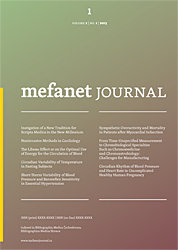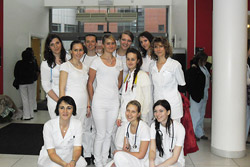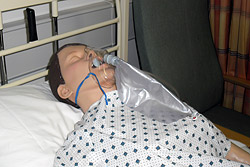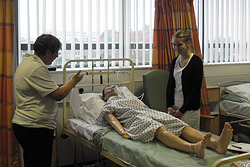
MEFANET Journal 2013; 1(2): 55-60
ORIGINAL ARTICLE
Innovative teaching methods in the professional training of nurses – simulation education
Michaela Miertová*, Martina Lepiešová
Institute of Nursing, Jessenius Faculty of Medicine in Martin, Comenius University in Bratislava, Slovakia
* Corresponding author: miertova@jfmed.uniba.sk
Abstract
Article history:
Received 25 September 2013
Revised 15 November 2013
Accepted 22 November 2013
Available online 2 December 2013
Peer review:
Darja Jarošová, Anna Ovšonková
 Download PDF
Download PDF
Introduction: The article is aimed to highlight usage of innovative teaching methods within simulation education in the professional training of nurses abroad and to present our experience based on passing intensive study programme at School of Nursing, Midwifery and Social Work, University of Salford (United Kingdom, UK) within Intensive EU Lifelong Learning Programme (LPP) Erasmus EU RADAR 2013.
Methods: Implementation of simulation methods such as role-play, case studies, simulation scenarios, practical workshops and clinical skills workstation within structured ABCDE approach (AIM© Assessment and Management Tool) was aimed to promote the development of theoretical knowledge and skills to recognize and manage acutely deteriorated patients. Structured SBAR approach (Acute SBAR Communication Tool) was used for the training of communication and information sharing among the members of multidisciplinary health care team. OSCE approach (Objective Structured Clinical Examination) was used for student’s individual formative assessment.
Results: Simulation education is proved to have lots of benefits in the professional training of nurses. It is held in safe, controlled and realistic conditions (in simulation laboratories) reflecting real hospital and community care environment with no risk of harming real patients accompanied by debriefing, discussion and analysis of all activities students have performed within simulated scenario. Such learning environment is supportive, challenging, constructive, motivated, engaging, skilled, flexible, inspiring and respectful. Thus the simulation education is effective, interactive, interesting, efficient and modern way of nursing education.
Conclusion: Critical thinking and clinical competences of nurses are crucial for early recognition and appropriate response to acute deterioration of patient’s condition. These competences are important to ensure the provision of high quality nursing care. Methods of simulation education used within professional training of next generation of nurses can help them to get used to the recognition and management of this group of patients by the means of simulated cases to be able to implement the approaches trained within real clinical nursing practice.
Keywords
teaching, training, educational activities, training programmes
Introduction
In clinical practice there are frequently patients manifesting the signs of physiological deterioration. If timely and appropriate detection by medical and nursing staff of physiological deterioration is undertaken it is likely to benefit the patients [1]. Patients who are admitted to hospital are entering a place of safety, where they, their families and carers have a right to believe that they will receive the best possible care [2]. Recognizing the deterioration of patient (whether child or adult) and referring to critical care is a highly complex process, requiring skill, experience and confidence [3]. Nurses and other health care professionals are under increased scrutiny to provide safe and effective care [4]. According to clinical guidelines (e.g. NICE Clinical Guideline: Acutely Ill Patient in Hospital, Recognition of and Response to Acute Illness in Hospital, 2007; European Resuscitation Council Guidelines for Resuscitation, 2010) nurses must be competent to perform care of patient who is acutely ill (acutely deteriorated) [5].
Early recognition (assessment) and appropriate response (management) to patients who are in the condition of acute deterioration are the core themes of the project EU RADAR. It is 3-year Erasmus Intensive Programme (Erasmus IP) for nursing students focused on the competence to recognize and respond properly to the acutely deteriorating patients of all ages (children, adults, seniors) with the respect to ethical, legal and socio-cultural aspects of health care provision within clinical practice of each participating country. In this project the Institute of Nursing at the Jessenius Faculty of Medicine in Martin belonging to Comenius University in Bratislava (Slovak Republic) is one of seven participating universities, along with School of Nursing, Midwifery and Social Work, University of Salford (United Kingdom), Tampere University of Applied Sciences (Finland), Fulda University of Applied Sciences (Germany), Cyprus University of Technology (Cyprus), University of Cordoba (Spain), Winona State University (USA). The University of Salford was the host university for the first year of IP for 26 lectures and 65 students in the period from 11 to 22 February 2013.
According to European Commission, ERASMUS Intensive Programme (IP) is a short programme of study which brings together students and teaching staff from higher education institutions of at least three participating countries. It can last from 10 continuous full days to 6 weeks of subject related work.
IP generally aims at encouraging efficient and multinational teaching of specialist topics which might otherwise not be taught at all, or only in a very restricted number of higher education institutions; enabling students and teachers to work together in multinational groups and thus benefit from special learning and teaching conditions not available in a single institution, and to gain new perspectives on the topic being studied; allowing members of the teaching staff to exchange views on teaching content and new curricula approaches and to test teaching methods in an international classroom environment. IP should provide something significantly new in terms of learning opportunities, skills development, access to information, etc. for the participating teachers and students and promote an element of curricular development.
EU RADAR undergraduate nursing intensive educational programme is innovative in teaching methods used – a combination of clinical simulations, blended learning and the use of digital and creative media [6]. From an educational perspective, the amount of knowledge required for safe patient care requires the adoption of a pedagogy that goes beyond traditional didactic teaching. Traditional education relies heavily on linguistic intelligence and rote memorization. In contrast, a well-designed simulation curriculum draws upon multiple intelligences and is learner-centred [7]. When compared with traditional teaching methods emphasizing linear thinking, the simulation education emphasizes critical thinking skills [8]. Today, simulations are being used in a variety of programmes (including nursing and medical education) designed to enhance the skills of health care providers.
Methods
In the two weeks of first IP programme several innovative teaching and educational methods were used in combination, e.g. simulation educational methods with the use of human patient simulators, progressive digital and creative methods with the use of information technologies, digital and creative media. These methods, such as flash mob, time capsule, podcasts creations and photo stories were used to promote the idea of the programme to bring together students and teachers from various countries and cultures to facilitate multicultural communication with the aim to share experiences in the field. By systematic implementation of advanced simulation educational methods (simulations of patients’ scenarios, case study group works, practical workshops, intensive clinical skills workstations with the emphasis on ABCDE approach application) and dramatic educational techniques (drama, role-play, communication games with the use of SBAR reporting approach) accompanied by discussions, debate, debriefing and reflections on actions, clinical decision making process in recognition and response to deteriorating patient was promoted in nursing student participants. ABCDE approach and SBAR reporting approach were trained within this programme as they are efficient particularly in the care of acutely deteriorating patients and are obviously used by health care professionals in hosting country. Simulation educational methods took place in simulation laboratories to train clinical skills and competences of nursing students related to the topic. Simulation laboratories in hosting university reflect real hospital and community care environment.
Figure 1: International pan European / American dimension of EU RADAR project
Figure 2: Authors of the article together with the group of Slovak students
Figure 3: Sophisticated computer-controlled life-sized mannequins used within simulation educational methods
Figure 4: Student’s individual formative assessment with the use of OSCE approach
Systematic ABCDE approach to resuscitation is included in European Resuscitation Council Guidelines for Resuscitation 2010. It provides the essential treatment algorithms for the resuscitation of children and adults [5]. The approach is widely accepted by experts in clinical practice, e.g. emergency units, hospital wards, and improves outcomes by helping health care professionals to be focused on the most life-threatening clinical problems. The high-quality ABCDE skills among all healthcare team members can save valuable time and improve team performance and efforts and thereby improve patients’ outcomes [9]. ABCDE approach (AIM© Assessment and Management Tool) used within EU RADAR programme is adopted by Greater Manchester Critical Care Skills Institute, National Health Service (NHS). It is a structured assessment and management tool to recognize acutely deteriorating patient’s condition and respond appropriately prior resuscitation can be initiated. This tool is recommended to be used also in professional training of the next generation of nurses. ABCDE approach was used e.g. to train assessment and management of acutely deteriorating patient (child, adult) within intensive clinical skills workstations where mixed groups of students from all participating countries had trained together [6].
SBAR reporting approach (Acute SBAR Communication Tool, Greater Manchester Critical Care Skills Institute, NHS) is a tool to improve communication and information sharing among the members of a multidisciplinary team. SBAR can be applied in both verbal and written communication [4]. Using the method of role-play this approach was trained in IP programme within the workshop Communication Games and Activities to highlight SBAR. Role play as a simulation method is effective to provide knowledge regarding the nursing contribution to effective communication when assessing and responding to the acutely deteriorating patient [6].
Within EU RADAR IP programme, human patient simulators (sophisticated computer-controlled life-sized mannequins to simulate range of symptoms and signs in infants, school age children, adults) have been used to train clinical skills and competences in student nurses. Using human patient simulators is a relatively new teaching strategy that allows learners to develop, refine, and apply knowledge and skills in a realistic clinical situation as they participate in interactive learning experience designed to meet their educational needs. These interactive mannequins are capable of realistic physiologic responses, including respiration, pulse rate, heart sounds, breath sounds, urinary output, and pupil reaction. Additionally, the more advanced models can communicate with the student, responding to questions posed by the learner in real time during the simulation exercise [4]. Human patient simulators were used together with partial task trainers during simulations of patient scenarios, practical workstations and also within final assessment of competences and skills achieved in nursing students (OSCE) [6].
Various methods, such as role play and simulations of patient scenarios, intensive clinical skill workstations, practical workshops, case study group work and debate have been used to improve clinical competences of nursing student. These modern teaching and educational methods were used e.g. to identify structural differences and physiological parameters across the lifespan in care of acutely ill patient; to train the procedures and equipment usage in the care of acutely deteriorating patient; to discuss legal, ethical and professional issues related to the care of dead patients, bereavement support. Debate Is restraint necessary? was used to facilitate students’ reflection of professional, legal and ethical issues related to restraints used in the care of acutely deteriorating patient [6]. Debriefing was performed at the end of each simulation scenario. Through debriefing, the students were able to explore their own experiences and views whilst developing the understanding of the importance of clinical assessment [6]. Debriefing is considered to be the most important element of simulation and most valuable in producing gains in knowledge [10]. Debriefing, also referred to as guided reflection, is a planned session after the simulation and is led by the instructor, who provides students with the time to assess their decisions, actions, communication, and ability to deal with the unexpected [11]. Discussions and reflection were used in IP programme with the aim to improve student’s understanding, self-confidence and to demonstrate learning to work in a multidisciplinary team context [6].
Contributors to the programme further enhanced a multidisciplinary approach as students were exposed to presentations from the North West Ambulance Service, the Royal Air Force / C Cast team, personnel of the Greater Manchester Critical Care Skills Institute, Creative Writing Team, Patients from the User and Carer Group and Performing Art Students. Students could get an overview of the work of health care teams from real practice about how they approach and manage the care of acutely ill patients. The students also had the opportunity to experience digital and creative methods using information technology and media such as flash mob, time capsule, podcasts creations, and photo stories. It was very interesting for them as they could develop awareness for digital and social media tools and strategies and their usefulness and security issues [6].
OSCE approach (Objective Structured Clinical Examination) was used for student’s individual formative assessment. OSCE was used with the aim to assess safe practice in terms of performance of psychomotor skills as well as the declarative and schematic knowledge associated with their application [12]. It represents a performance-based exam in which students are observed demonstrating a multitude of clinical behaviours [13]. Within formative assessment the students had to apply ABCDE approach to assess and manage acutely deteriorating patient simulated on human patient simulator. At the end of formative assessment they were asked to apply SBAR reporting approach to report the situation of simulated patient to the teachers and facilitators.
Results
Through collation of the student evaluations by the means of student survey it has been acknowledged that the objectives of the programme were achieved as for academic learning outcomes and expected personal outcomes as well. Evaluation forms prepared by hosting university used Likert type scale from 1 to 5 to measure what is overall evaluation of IP and how satisfied they were with selected aspects (1-poor / not at all; 5-excellent / very much). Student participants were satisfied with academic activities and the pedagogical aspects of IP. High level of satisfaction was in number of hours, expected learning outcomes, activities besides the general course. Students proved high level of satisfaction with IP (4,43 ± 0,53) and agreed their academic learning outcomes as well as personal outcomes were met (4,43 ± 0,59; 4,44 ± 0,59 respectively). The highest satisfaction was achieved in items concerning the equipment used while training (4,79 ± 0,44) and the overall quality of teaching (4,75 ± 0,43). Up-to-date we have no country specific results and all the results published are overall results of whole sample of nursing students (n = 65).
Discussion and conclusion
Critical thinking and clinical competences of nurses are crucial for early recognition and appropriate response to acute deterioration of patient’s condition. These competences are important to ensure the provision of high quality nursing care. Methods of simulation education used within professional training of next generation of nurses can help them to get used to the recognition and management of this group of patients by the means of simulated cases to be able to implement the approaches trained within real clinical nursing practice.
Simulation education used within IP allowed participating students to improve their knowledge, gain clinical competence and improve self-confidence to recognize and respond appropriately to acute deteriorating patient’s condition prior to resuscitation, when a patient’s vital signs indicate he/she is becoming acutely unwell [6]. This type of education has lots of benefits in professional training of nurses. It is realized in safe, controlled and realistic environment of simulation laboratories reflecting real hospital and community care environment (specific clinical environment) with no risk of harming real patients. Simulation can be also used to train individuals in the context of team activities, creating a more realistic clinical environment. It contributes to creation of learning environment that is supportive, challenging, constructive, motivated, engaging, skilled, flexible, inspiring and respectful [14]. Thus simulation education is effective, interactive, interesting, efficient and modern way of nursing education. The use of simulation as a teaching strategy can contribute to patients’ safety and optimize outcomes of care, providing learners with opportunities to experience scenarios and intervene in clinical situations within a safe, supervised setting without posing a risk to a patient [4]. This is excellent teaching strategy for many skills, particularly in critical care nursing. It can be used in professional training of nurses to teach the theory, assessment, technology, pharmacology, skills, knowledge and critical thinking [8].
The EU RADAR IP programme brought benefits for both the students and the teachers. It allowed the students to gain new knowledge and practical skills and competences in a pan European/American context (multicultural), and to make new friends. For teachers it was a great opportunity to acquire new contacts, mutual inspiration and motivation to introduce and implement progressive teaching methods in order to improve professional training of nurses. Further details of the project are presented on the EU RADAR project webpage (http://euradar.org/). 2nd year of the project will continue at the Fulda University of Applied Sciences in Germany, in February 2014.
References
[1] Kause J, Smith G, Prytherch D, Parr M, Flabouris A, Hillman K. A comparison of antecedents to cardiac arrest, deaths and emergency intensive care admissions in Australia and New Zealand, and the United Kingdom - the ACADEMIA study. Resuscitation 2004; 62(3): 275-282.
[2] NICE clinical guideline 50. Acutely ill patients in hospital. Recognition of and response to acute illness in hospital. [On-line] National Institute for Health and Clinical Excellence, 2007. p. 27. [cit. 2013-09-12]. Available at WWW: <http://www.nice.org.uk/nicemedia/live/11810/58247/58247.pdf>.
[3] Odell M. Victor C, Oliver D. Nurses’ role in detecting deterioration in ward patients: systematic literature review. J Adv Nurs 2009; 65(10): 1992-2006.
[4] Durham CF, Alden KR. Enhancing patient safety in nursing education through patient simulation [On-line] In: Hughes RG (ed). Patient Safety and Quality: An Evidence-Based Handbook for Nurses. Rockville, MD: Agency for Healthcare Research and Quality (US) 2008. Chapter 51. [cit. 2013-09-17]. Available at WWW: <http://www.ncbi.nlm.nih.gov/books/NBK2628/>.
[5] Nolan JP, Soar J, Zideman DA, Biarent D, Bossaert LL, Deakin Ch, Koster RW, Wyllie J, Böttiger B. European Resuscitation Council Guidelines for Resuscitation 2010, Section 1. Executive summary. Resuscitation 2010; 81(10): 1219-1276.
[6] Stephens M et al. EU Radar Facilitators Handbook. Unpublished material within year 1 of IP programme EU RADAR in the University of Salford 2013; 74 p.
[7] Galloway S. Simulation techniques to bridge the gap between novice and competent healthcare professionals. The Online Journal of Issues in Nursing 2009; 14(2), Manuscript 3.
[8] Rauen CA. Simulation as a Teaching Strategy for Nursing Education and Orientation in Cardiac Surgery. Crit Care Nurse 2004; 24(3): 46-51.
[9] Thim T, Krarup NHV, Grove EL, Rohde CV, Løfgren B. Initial assessment and treatment with the Airway, Breathing, Circulation, Disability, Exposure (ABCDE approach). Int J Gen Med 2012; 5: 117-121.
[10] Shinnick MA, Woo M, Horwich TB, Steadman R. Debriefing: the most important component in simulation? Clin Sim Nurs 2011; 7(3): e105-e111.
[11] Decker S. Integrating guided reflection into simulated learning experiences. In: Jeffries PR (ed). Simulation in nursing: From Conceptualization to Evaluation. National League for Nursing: New York 2007: 73-85. ISBN-13 978-0-97-795574-9, ISBN-10 097-79-5574-5.
[12] Mitchel ML, Henderson A, Groves M, Dalton M, Nulty D. The objective structured clinical examination (OSCE): optimising its value in the undergraduate nursing curriculum. Nurse Educ Today 2009; 29(4): 398-404.
[13] McWilliam PL, Botwinski CA. Identifying strengths and weaknesses in the utilization of Objective Structured Clinical Examination (OSCE) in a nursing program. Nurs Educ Perspect 2012; 33(1): 35-39.
[14] Kyle RR Jr., Murray WB. Clinical simulation. Operations, Engineering, and Management. Elsevier 2008. ISBN 978-0-12-372531-8.
Please cite as:
Miertová M, Lepiešová M. Innovative teaching methods in the professional training of nurses – simulation education. MEFANET Journal 2013; 1(2): 55-60. Available at WWW: http://mj.mefanet.cz/mj-02130925.
This is an open-access article distributed under the terms of the Creative Commons Attribution-NonCommercial-ShareAlike 3.0 License (http://creativecommons.org/licenses/by-nc-sa/3.0/), which permits unrestricted use, distribution, and reproduction in any medium, provided the original work, first published in the MEFANET Journal, is properly cited. The complete bibliographic information, a link to the original publication on http://www.mj.mefanet.cz/, as well as this copyright and license information must be included.














